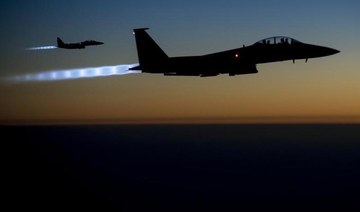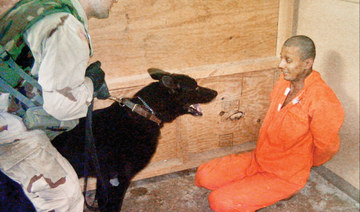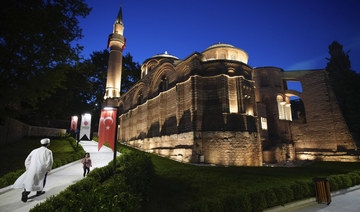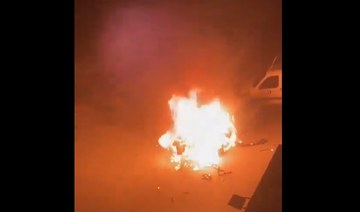SAMARRA, Iraq: Seven rockets targeted an Iraqi air base housing US troops north of Baghdad on Monday, a security source said, the latest in a string of attacks Washington routinely blames on Iran-linked factions.
The evening attack on Al-Balad did not cause any casualties or damage inside the base, the security official said.
The other five rockets crashed into a nearby village, he added, noting that all seven were fired from a separate village in the neighboring province of Diyala, east of the base.
There was no immediate claim of responsibility.
There have been several such attacks in recent weeks targeting locations where US forces operate.
On March 3, an American sub-contractor was killed in a similar attack against another air base, Ain Assad, in Iraq’s western desert.
That came days after the US bombed a border depot in neighboring Syria which the Pentagon said was used by Iran-backed Iraqi armed militia that have been tied to the rocket attacks.
US President Joe Biden described the February 25 raid as a “warning” to Iran.
Dozens of rocket attacks and roadside bombs targeted Western security, military and diplomatic sites in Iraq in 2020, blamed by Iraqi and Western military sources on hard-line pro-Iran factions.
The attacks had come to a near-complete halt in October following a truce with the hard-liners, but have since resumed.
7 rockets target Iraq base housing US troops: security source
https://arab.news/mhxd9
7 rockets target Iraq base housing US troops: security source

- No group immediately claimed the attack
- There were no reports of casualties
What do we know so far about the mysterious crash of the helicopter carrying Iran’s president?

- Initially, Interior Minister Ahmad Vahidi said the helicopter “was forced to make a hard landing due to the bad weather and fog”
BEIRUT: The apparent crash of a helicopter carrying Iran’s president and foreign minister on Sunday sent shock waves around the region.
Details remained scant in the hours after the incident, and it was unclear if Iranian President Ebrahim Raisi and the other officials had survived.
Here’s what we know so far.
WHO WAS ON BOARD THE HELICOPTER AND WHERE WERE THEY GOING?
The helicopter was carrying Iranian President Ebrahim Raisi, the country’s Foreign Minister Hossein Amirabdollahian, the governor of Iran’s East Azerbaijan province and other officials and bodyguards, according to the state-run IRNA news agency. Raisi was returning from a trip to Iran’s border with Azerbaijan earlier Sunday to inaugurate a dam with Azerbaijan’s President Ilham Aliyev, the news agency said.
WHERE AND HOW DID THE HELICOPTER GO DOWN?
The helicopter apparently crashed or made an emergency landing in the Dizmar forest between the cities of Varzaqan and Jolfa in Iran’s East Azerbaijan province, near its border with Azerbaijan, under circumstances that remain unclear. Initially, Interior Minister Ahmad Vahidi said the helicopter “was forced to make a hard landing due to the bad weather and fog.”
WHAT IS THE STATUS OF THE SEARCH OPERATIONS?
Iranian officials have said the mountainous, forested terrain and heavy fog impeded search-and-rescue operations. The president of the Iranian Red Crescent Society, Pir-Hossein Koulivand, said 40 search teams were on the ground in the area despite “challenging weather conditions.” The search is being done by teams on the ground, as “the weather conditions have made it impossible to conduct aerial searches” via drones, Koulivand said, according to IRNA.
IF RAISI DIED IN THE CRASH, HOW MIGHT THIS IMPACT IRAN?
Raisi is seen as a protégé to Iran’s supreme leader Ayatollah Ali Khamenei and a potential successor for his position within the country’s Shiite theocracy. Under the Iranian constitution, if he died, the country’s first vice president, Mohammad Mokhber, would become president. Khamenei has publicly assured Iranians that there would be “no disruption to the operations of the country” as a result of the crash.
WHAT HAS THE INTERNATIONAL REACTION BEEN?
Countries including Russia, Iraq and Qatar have made formal statements of concern about Raisi’s fate and offered to assist in the search operations.
Azerbaijani President Aliyev said he was “deeply concerned” to hear of the incident, and affirmed that Azerbaijan was ready to provide any support necessary. Relations between the two countries have been chilly due to Azerbaijan’s diplomatic relations with Israel, Iran’s regional arch-enemy.
Saudi Arabia, which is traditionally a rival of Iran although the two countries have recently made a rapprochement, also expressed concern in a statement and said it “stands by Iran in these difficult circumstances.”
There was no immediate official reaction from Israel. Last month, following an Israeli strike on an Iranian consular building in Damascus that killed two Iranian generals, Tehran launched hundreds of missiles and drones at Israel. They were mostly shot down and tensions have apparently since subsided.
EU Red Sea mission says it defended 120 ships from Houthi attacks

- Human rights activist raps cases of prisoner fatalities as a result of torture in militia’s captivity
AL-MUKALLA, Yemen: The EU mission in the Red Sea, known as EUNAVFOR Aspides, said on Sunday that it had protected over 100 ships while sailing the critical trade channel and shot down more than a dozen Houthi missiles and drones in the last three months.
In a post on X marking three months since the start of its operation, the EU mission, which is now made up of five naval units and 1,000 personnel from 19 contributing nations, said that its forces had destroyed 12 drones, one drone boat, and four ballistic missiles fired by the Houthis from areas under their control in Yemen, as well as provided protection to 120 commercial ships since February.
“Great day for Freedom of Navigation, as 3 months have passed since the launch of ASPIDES. Three months of multiple challenges and great achievements. ASPIDES continues its mission in full compliance with international law, to ensure maritime security and seaborne trade,” EUNAVFOR Aspides said.
On Feb. 19, the EU announced the commencement of EUNAVFOR Aspides, a military operation in the Red Sea to defend international marine traffic against Houthi attacks.
At the same time, the Philippines Department of Migrant Workers said on Sunday that 23 of its citizens who were aboard the oil ship assaulted by Houthi militia in the Red Sea on Saturday were safe.
“The DMW is closely coordinating with international maritime authorities, shipping companies, and local manning agencies on the status of ships with Filipino seafarers traversing high-risk areas and war-like zones in the Red Sea and the Gulf of Aden,” the DMW said in a statement carried by the official Philippine News Agency.
For seven months, the Houthis have launched hundreds of ballistic missiles, drones, and drone boats against commercial and navy ships along international commerce lanes off Yemen, including the Red Sea.
The Houthis claim that their strikes are intended to push Israel to cease the war in Gaza and allow humanitarian supplies into the Palestinian territory.
Three civilian sailors, including two Filipinos, were killed in March after the Houthis launched a missile at their ship in the Red Sea.
Many international shipping companies directed their ships to avoid the Red Sea and other passages off Yemen, opting for longer and more costly routes through Africa.
Meanwhile, Yemen human rights activists have said that a man held by the Houthis during the last seven years died as a result of abuse in Houthi imprisonment, making him the latest victim of torture within Houthis detention facilities.
On Saturday, the Houthis told the family of Najeed Hassan Farea in Taiz through the Yemen Red Crescent that their son had died in their custody, but they did not explain how.
The Houthis abducted Farea in February 2017 after storming his village and home in the Al-Taziya district, preventing him from contacting his family and denying them information about where he was being detained.
Eshraq Al-Maqtari, a human rights activist in Taiz who reached Farea’s family, told Arab News that the Houthis cruelly tortured the man and that his family was stunned to hear of his death after years of information blackout since his detention.
“He was denied the right to communicate, to know his fate, and the right to healthcare, which appears to have caused his death,” she said, adding that since the start of the year, there have been three verified cases of prisoner fatalities as a result of torture in Houthi captivity.
10 years on, thousands forgotten in Syria desert camp

- Rukban camp was established in 2014 as desperate people fled Daesh and Syrian regime bombardment in hopes of crossing into Jordan
BEIRUT: In a no-man’s land on Syria’s border with Iraq and Jordan, thousands are stranded in an isolated camp, unable to return home after fleeing the regime and militants years ago.
When police defector Khaled arrived at Rukban, he had hoped to be back home within weeks — but eight years on, he is still stuck in the remote desert camp, sealed off from the rest of the country.
Damascus rarely lets aid in and neighboring countries have closed their borders to the area, which is protected from Syrian forces by a nearby US-led coalition base’s de-confliction zone.
“We are trapped between three countries,” said Khaled, 50, who only gave his first name due to security concerns.
“We can’t leave for (other areas of) Syria because we are wanted by the regime, and we can’t flee to Jordan or Iraq” because the borders are sealed, he added.
The camp was established in 2014, at the height of Syria’s ongoing war, as desperate people fled Daesh and regime bombardment in hopes of crossing into Jordan.
At its peak, it housed more than 100,000 people, but numbers have dwindled, especially after Jordan largely sealed its side of the border in 2016.
Many people have since returned to regime-held areas to escape hunger, poverty and a lack of medical care. The UN has also facilitated voluntary returns with the help of the Syrian Arab Red Crescent.
The last UN humanitarian convoy reached the camp in 2019, and the body described conditions there as “desperate” at the time.
Today, only about 8,000 residents remain, living in mud-brick houses, with food and basic supplies smuggled in at high prices.
Residents say even those meager supplies risk running dry as regime checkpoints blocked smuggling routes to the camp about a month ago.
Egyptian churches begin preparations to celebrate anniversary of Holy Family’s journey

CAIRO: Egypt’s Coptic community is preparing to celebrate the Feast of the Entry of the Holy Family into Egypt, starting on June 1.
Churches in the country have begun early preparations to welcome visitors, focusing on securing and preparing the sites along the journey the Holy Family is believed to have taken.
Robier El-Fares, an Egyptian Coptic researcher for Arab News, said: “The celebration of the journey of the Holy Family is a relatively new tradition that benefits religious tourism in Egypt. This comes after many years of neglecting the celebration.”
He added: “The route includes about 20 locations that represent the journey from Bethlehem in Palestine, fleeing the persecution of Herod who intended to kill Jesus Christ, and their subsequent travel to Egypt through plateaus and deserts.”
Father Augustinos Morris, priest of the Holy Family Church in Zeitoun, Cairo, for the Coptic Catholics, told Arab News: “Masses will be held at nine in the morning and six in the evening for all Copts who wish to participate. The readings are from Matthew 2, which discusses the flight into Egypt, and include a passage from the Old Testament in the Bible, amid the procedures followed in the holiday masses organised by the scout team.”
Father Matta Philip, priest of St. Mary’s Church in Maadi, Cairo, said: “The church is considered the first point of the Holy Family’s journey to Upper Egypt through a staircase, from there to a boat and then to Upper Egypt.”
He said: “Inside the Church of the Virgin Mary in Maadi, there is an icon depicting the life of the Virgin Mary, the altar vessels, and the Bible open to the verse — ‘Blessed be my people Egypt,’ — and a map of the family's route that starts from Arish and extends to the Monastery of Al-Muharraq.”
“Inside the church is the historic staircase that the Holy Family crossed, with an altar at its beginning where prayers are held,” he said. “From this staircase, the family headed to areas like Al-Bahnasa and Mount Al-Tair and other routes to the Monastery of Al-Muharraq, a journey that took about six months.”
Robier El-Fares said: “The known points of the Holy Family’s journey are 20, starting from Farma, located between the cities of Arish and Port Said, then to Tel Basta.”
“In Cairo, there are many points through which the Holy Family passed, including the area of Ain Shams, in addition to other areas in Maadi and Zeitoun, to start the points of Upper Egypt (southern Egypt), which are numerous including Gabal Al-Tair in Minya, and the Monastery of the Virgin Mary,” he said.
Supporters of Hezbollah and Amal protest in Beirut against security plan

- Security Forces warn against attacks on their units and members
- MP fears concerted campaign against interior minister
BEIRUT: Motorcycle owners in Beirut and the southern suburbs have protested against a security plan launched by the Ministry of Interior in the capital since Monday.
The protests reached their peak with gunfire being exchanged between the protesters and the internal security forces in the heart of the southern suburbs of Beirut.
The situation worsened on Sunday as protesters marched to the Ministry of Interior, claiming that the decision to confiscate unregistered motorcycles was being made randomly and arbitrarily while the vehicle registration office had been closed for years.
Thousands of young men and women have turned to using motorcycles as an alternative to cars since 2019 amid Lebanon’s economic crisis.
The shift has led to a rise in motorcycle thieves targeting people at the entrances of Beirut, particularly on the airport road and highways to the suburbs.
A Lebanese security source said that thieves often seek refuge in Palestinian refugee camps at the entrances of Beirut or in slums in the southern suburbs of Beirut, where illegal weapons are prevalent.
Social media activists shared videos of security forces confiscating motorcycles, while owners claimed the registration service was inaccessible, leading to a lack of registration.
For more than four years, tens of thousands of transactions have accumulated in the vehicle registration department without market licenses, car books, electronic stickers or license plates being issued.
This is due to the crisis of fluctuating exchange rates between the government and contractors — especially contracts in dollars.
In addition to this crisis, corruption investigations are being conducted.
The southern suburbs of Beirut, a stronghold for Hezbollah and the Amal Movement supporters, saw clashes between protesters and security forces on Saturday night.
The supporters held motorcycle rallies to oppose the security plan.
Protesters gathered around the Al-Marija Police Station to chant the message to Interior Minister Bassam Mawlawi that the situation was not under his control.
The Internal Security Forces said that the protesters fired in the air, and the police officers fired in the air to remove them from the site. There was no deaths or injuries among the protesters or the police, as claimed by some social media sites, according to authorities.
The security plan started on May 15, following a meeting of security service leaders 10 days before.
The meeting focused on Beirut’s security due to the increase in pickpocketing, theft, weapon threats and drug trafficking using motorcycles.
The security plan is based on strict measures aimed at maintaining security.
Traffic police units in Beirut and the southern suburbs conduct patrols day and night, with support from various units of the Internal Security Forces, such as the Fuhud forces, the judicial police and others.
Protesters have been blocking main roads with burning tires during afternoon rush hours for days.
Some affected roads include Sports City Road, Mazraa Corniche and the Mar Mikhael-Chiyah intersection.
A political observer expressed concern that “the protest in the heart of the southern suburb of Beirut against one of the state’s police stations may have been carried out with direct cover from Hezbollah, which rejects any disturbance to this environment. Hezbollah maintains a stable security grip in the southern suburb of Beirut while focusing on its war on the southern front against the Israeli army.”
One of the most prominent objections was a statement by the mayor of Ghobeiry, Maan Al-Khalil, who is close to Hezbollah.
The mayor protested against “the confiscation of motorcycles and vehicles belonging to the municipality and driven by municipal employees.”
Beirut MP Nabil Badr said that there was a campaign targeting the interior minister, who is committed to safeguarding the Lebanese people’s safety.
The MP said: “From the start of the security operation, we have urged a comprehensive effort in government agencies, particularly the Car and Motorcycle Registration Department, to help citizens resolve their breaches. The minister has acknowledged the issues and assured that the strict measures will be eased.”
Badr fears that “the campaign aims to create complete chaos in the streets of the capital and its suburbs among those affected by the imposition of security and state prestige. This is something we categorically reject.”
In a statement released on Sunday, the Internal Security Forces rejected “any attacks on their units and members, regardless of the excuses.”
They said that the security plan was requested to protect citizens on public roads from theft, robbery and reckless motorcycle riders, as well as their failure to wear helmets, which has led to an increase in traffic accident deaths.
The security plan aimed to protect people, they said, not to seek revenge or retaliate against them, and, according to authorities, has resulted in a significant decrease in crimes.





















